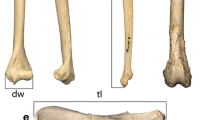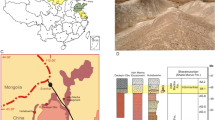Abstract
New previously unstudied geese bones (two coracoids and tarsometatarsus) are described from the late Miocene locality Hyargas Nuur 2 in Western Mongolia. A tarsometatarsus, previously unknown for Anser devjatkini Kurochkin, 1971, indicates close phylogenetic relationships of this extinct species with modern grey geese. Previously noted similarity with white geese is treated as plesiomorphic. Morphological transition from white to grey geese thus was associated with changes in locomotor specialization of the hind limb (swimming versus running adaptations). Two coracoids are different from those in modern Anser and Branta, but are close to “Branta” woolfendeni Bickart, 1990 from the late Miocene of Arizona (USA), from which they differ in their bigger size. These latter finds represent a distinct extinct unnamed genus of geese, which was widespread across Central Asia and North America in the late Miocene. Late Miocene evolution and paleogeography of geese is further discussed. The remarkable diversity of geese at the Hyargas Nuur locality (at least 3‒4 species) may be explained by wintering of these birds on the large lakes of Central Asia.

Similar content being viewed by others
references
Baumel, J.J., King, A.S., Breazile, J.E., Evans, H.E., and Vanden Berge, J.C., Handbook of Avian Anatomy: Nomina Anatomica Avium, Cambridge, Mass.: Nuttall Ornithol. Club, 1993.
Bickart K.J., The birds of the late Miocene–early Pliocene Big Sandy Formation, Mohave County, Arizona, Ornithol. Monogr., 1990. vol. 44, pp. 1–72.
Devyatkin, E.V., Magnetostratigraphic scheme of the Cenozoic of Mongolia, Stratigr. Geol. Correl., 1994, vol. 2, no. 2, pp. 35–45.
Gonzalez, J., Düttmann, H., and Wink, M., Phylogenetic relationships based on two mitochondrial genes and hybridization patterns in Anatidae, J. Zool, 2009, vol. 279, pp. 310–318.
Kurochkin, E.N., Contribution to the avifauna of the Pliocene of Mongolia, Fauna mezozoya i kainozoya Zapadnoi Mongolii (Fauna of the Mesozoic and Cenozoic of Western Mongolia), Trofimov, B.A., Ed., Tr. Sovm. Sov.-Mongol. Nauchno-Issled. Geol. Eksp., vol. 3, Moscow: Nauka, 1971, pp. 58–67.
Kurochkin, E.N., New data on the Pliocene birds from Western Mongolia, Paleontologiya i biostratigrafiya Mongolii (Paleontology and Biostratigraphy of Mongolia), Kramarenko, N.N., Ed., Tr. Sovm. Sov.-Mongol. Paleontol. Eksp., vol. 3, 1976, Moscow: Nauka, pp. 51–67.
Kurochkin, E.N., Ptitsy Tsentralnoi Azii v Pliotsene (Birds of Central Asia in the Pliocene), Tr. Sovm. Sov.-Mongol. Paleontol. Eksp., vol. 26, Moscow: Nauka, 1985.
Mlíkovský, J. and Švec, P., Review of the Tertiary waterfowl (Aves: Anseridae) of Asia, Věst. Čs. Společ.Zool., 1986, vol. 50, pp. 249–272.
Pevzner, M.A., Vangengeim, E.A., Zhegallo, V.I., Zazhigin, B.C., and Liskun, I.G., Correlation of Late Neogene sediments of Central Asia and Europe according to paleomagnetic and biostratigraphic data, Izv. Akad. Nauk., Ser. Geol., 1982. no. 6, pp. 5–15.
Portenko, L.A., Ptitsy Chukotskogo Poluostrova i Ostrova Vrangela, Chast’ 1 (Birds of the Chukchi Peninsula and Wrangel Island. Part 1), Leningrad: Nauka, 1972.
Ptitsy Sovetskogo Soyuza. Tom IV (Birds of the Soviet Union. Vol. IV), Dementiev, G.P. and Gladkov, N.A., Eds., Moscow: Sovetskaya Nauka, 1952.
Sun Zhong-lou, Pan Tao, Hu Chao-chao, Sun Lu, Ding Heng-wu, Wang Hui, Zhang Chen-ling, Jin Hong, Chang Qing, Kan Xian-zhao, and Zhang Bao-wei, Rapid and recent diversification patterns in Anseriformes birds: Inferred from molecular phylogeny and diversification analyses, PLoS One, 2017, vol. 12, e0184529.
Vangengeim, E.A., Pevzner, M.A., and Tesakov, A.S., Ruscinium and Lower Villafranchian: age of boundaries and position in magnetochronological scale, Stratigr. Geol. Correl., 2005, vol. 13, no. 5, pp. 530–546.
Velichko, A.A., General features of the landscape and climate of Northern Eurasia in the Cenozoic, Geol. Soc. Amer. Spec. Pap., 2005, vol. 382, pp. 189–201.
Zazhigin, V.S. and Lopatin, A.V., The history of Dipodoidea (Rodentia, Mammalia) in the Miocene of Asia: 4. Dipodinae at the Miocene–Pliocene transition, Paleontol. J., 2001, vol. 35, no. 1, pp. 60–74.
Zelenkov, N.V., A new duck from the middle Miocene of Mongolia, with comments on Miocene evolution of ducks, Paleontol. J., 2012a, vol. 46, no. 5, pp. 520–530.
Zelenkov, N.V., Neogene geese and ducks (Aves: Anatidae) from localities of the Great Lakes Depression, Western Mongolia, Paleontol. J., 2012b, vol. 46, no. 6, pp. 607–619.
Zelenkov, N.V., Stages in the evolution of modern taxonomic diversity of birds (based on paleontological data), Zool. J., 2014, vol. 93, no. 10, pp. 1173–1185.
Zelenkov, N.V., The nomenclature of the skeleton of birds, Iskopaemye pozvonochnye Rossii i sopredel’nyh stran. Iskopaemye reptilii i ptitsy. Chast’ 3 (Fossil vertebrates of Russia and adjacent countries. Fossil reptiles and birds. Part 3), Kurochkin, E.N., Lopatin, A.V., and Zelenkov, N.V., Eds., Moscow: GEOS, 2015a, pp. 61–83.
Zelenkov, N.V., Stable morphological types and mosaicism in the macroevolution of birds (Neornithes), Biol. Bull. Rev., 2016a, vol. 6, no. 3, pp. 208–218.
Zelenkov, N.V. and Kurochkin, E.N., Class Aves, Iskopaemye pozvonochnye Rossii i sopredel’nyh stran. Iskopaemye reptilii i ptitsy. Chast’ 3 (Fossil Vertebrates of Russia and Adjacent Countries. Fossil Reptiles and Birds. Part 3), Kurochkin, E.N., Lopatin, A.V., and Zelenkov, N.V., Eds., Moscow: GEOS, 2015, p. 86–290.
Zelenkov, N.V., Evolution of bird communities in the Neogene of Central Asia, with a review of the fossil record of the Neogene Asian birds, Paleontol. J., 2016b, vol. 50, no. 12, pp. 1421–1433.
ACKNOWLEDGMENTS
The authors are grateful to the staff of the Historical Ecology Laboratory at the A.N. Severtsov Institute of Ecology and Evolution (Russian Academy of Sciences) and especially to A.B. Savinetsky and O.A. Krylovich for their friendly attitude and for giving us opportunity to work with the osteological collection of birds. We also thank M. Florence, National Museum of Natural History, Smithsonian Institution, and C. Mehling, American Museum of Natural History, for the opportunity to study fossil geese from the late Miocene of the United States. Special thanks to A.A. Karhu for the review and the detailed criticism of this article.
Funding
This work was supported by the Russian Foundation for Basic Research (project no. 17-04-01162) and PalSIRP Sepkoski Grant–2015.
Author information
Authors and Affiliations
Corresponding author
Additional information
Translated by D. Ponomarenko
Rights and permissions
About this article
Cite this article
Volkova, N.V., Zelenkov, N.V. On the Diversity and Morphology of Anserini (Aves: Anatidae) from the Late Miocene of Western Mongolia. Paleontol. J. 54, 73–80 (2020). https://doi.org/10.1134/S0031030120010128
Received:
Revised:
Accepted:
Published:
Issue Date:
DOI: https://doi.org/10.1134/S0031030120010128




